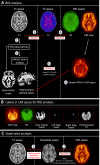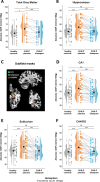Effects of diazepam on hippocampal blood flow in people at clinical high risk for psychosis
- PMID: 38658738
- PMCID: PMC11250854
- DOI: 10.1038/s41386-024-01864-9
Effects of diazepam on hippocampal blood flow in people at clinical high risk for psychosis
Abstract
Elevated hippocampal perfusion has been observed in people at clinical high risk for psychosis (CHR-P). Preclinical evidence suggests that hippocampal hyperactivity is central to the pathophysiology of psychosis, and that peripubertal treatment with diazepam can prevent the development of psychosis-relevant phenotypes. The present experimental medicine study examined whether diazepam can normalize hippocampal perfusion in CHR-P individuals. Using a randomized, double-blind, placebo-controlled, crossover design, 24 CHR-P individuals were assessed with magnetic resonance imaging (MRI) on two occasions, once following a single oral dose of diazepam (5 mg) and once following placebo. Regional cerebral blood flow (rCBF) was measured using 3D pseudo-continuous arterial spin labeling and sampled in native space using participant-specific hippocampus and subfield masks (CA1, subiculum, CA4/dentate gyrus). Twenty-two healthy controls (HC) were scanned using the same MRI acquisition sequence, but without administration of diazepam or placebo. Mixed-design ANCOVAs and linear mixed-effects models were used to examine the effects of group (CHR-P placebo/diazepam vs. HC) and condition (CHR-P diazepam vs. placebo) on rCBF in the hippocampus as a whole and by subfield. Under the placebo condition, CHR-P individuals (mean [±SD] age: 24.1 [±4.8] years, 15 F) showed significantly elevated rCBF compared to HC (mean [±SD] age: 26.5 [±5.1] years, 11 F) in the hippocampus (F(1,41) = 24.7, pFDR < 0.001) and across its subfields (all pFDR < 0.001). Following diazepam, rCBF in the hippocampus (and subfields, all pFDR < 0.001) was significantly reduced (t(69) = -5.1, pFDR < 0.001) and normalized to HC levels (F(1,41) = 0.4, pFDR = 0.204). In conclusion, diazepam normalized hippocampal hyperperfusion in CHR-P individuals, consistent with evidence implicating medial temporal GABAergic dysfunction in increased vulnerability for psychosis.
© 2024. The Author(s).
Conflict of interest statement
GM has received consulting fees from Boehringer Ingelheim. AE has received consulting fees from Leal Therapeutics. AAG has received funds from Lundbeck, Pfizer, Lilly, Roche, Janssen, Alkermes, Newron, Takeda and Merck. SCRW has recently received research funding from Boehringer Ingelheim and GE Healthcare to perform investigator-led research. All other authors have nothing to disclose.
Figures




Similar articles
-
Diazepam modulates hippocampal CA1 functional connectivity in people at clinical high-risk for psychosis.Psychol Med. 2025 Aug 8;55:e230. doi: 10.1017/S0033291725101268. Psychol Med. 2025. PMID: 40776396 Clinical Trial.
-
Increased hippocampal blood flow in people at clinical high risk for psychosis and effects of cannabidiol.Psychol Med. 2024 Apr;54(5):993-1003. doi: 10.1017/S0033291723002775. Epub 2023 Oct 17. Psychol Med. 2024. PMID: 37845827 Clinical Trial.
-
Oxytocin modulates hippocampal perfusion in people at clinical high risk for psychosis.Neuropsychopharmacology. 2019 Jun;44(7):1300-1309. doi: 10.1038/s41386-018-0311-6. Epub 2019 Jan 9. Neuropsychopharmacology. 2019. PMID: 30626906 Free PMC article. Clinical Trial.
-
Increased Striatal and Reduced Prefrontal Cerebral Blood Flow in Clinical High Risk for Psychosis.Schizophr Bull. 2018 Jan 13;44(1):182-192. doi: 10.1093/schbul/sbx070. Schizophr Bull. 2018. PMID: 28575528 Free PMC article.
-
Folic acid supplementation and malaria susceptibility and severity among people taking antifolate antimalarial drugs in endemic areas.Cochrane Database Syst Rev. 2022 Feb 1;2(2022):CD014217. doi: 10.1002/14651858.CD014217. Cochrane Database Syst Rev. 2022. PMID: 36321557 Free PMC article.
Cited by
-
Corticolimbic circuitry as a druggable target in schizophrenia spectrum disorders: a narrative review.Transl Psychiatry. 2025 Jan 24;15(1):21. doi: 10.1038/s41398-024-03221-2. Transl Psychiatry. 2025. PMID: 39856031 Free PMC article. Review.
References
Publication types
MeSH terms
Substances
Grants and funding
LinkOut - more resources
Full Text Sources
Medical
Miscellaneous

